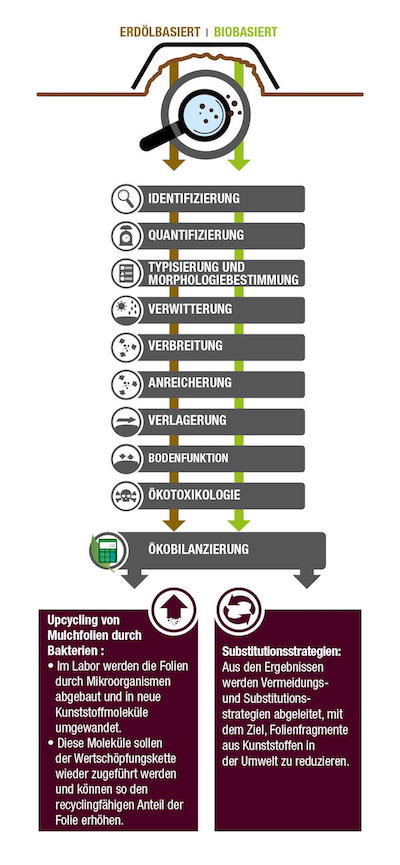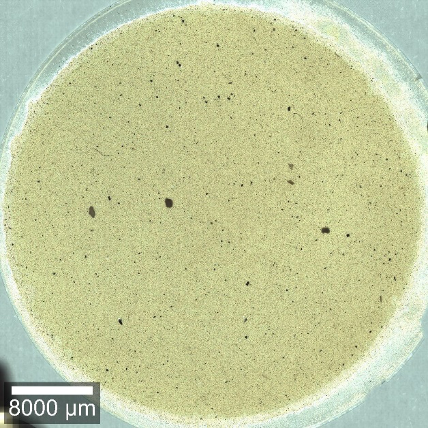The issue of plastic waste has become part of all social debates. However, the pollution of the ecological system soil still receives little attention. So, the question arises whether plastics that remain on soils or fields (incl. water from drainage systems) do not have similar effects on the environment as, for example, in seas, rivers or lakes?

The problem: Until now, there have been no valid measurement methods to answer questions about the amount, type or impact of plastics on the soil ecosystem. Therefore, scientists of the iMulch project (www.imulch.eu) are developing a test rig to investigate a total of nine criteria in order to better measure plastic emissions in the soil ecosystem in the future and to better assess their impact. The following investigation criteria will be developed in the project and established in the test rig: Identification (1), quantification (2), typing and morphology determination (3), weathering (4), dispersal (5), accumulation (6), relocation (7), soil function (8), ecotoxicity (9) (Figure 1).
In the meantime, researchers from the Institute for Energy and Environmental Technology e. V. (IUTA) in Duisburg, Fraunhofer Institute for Environmental, Safety and Energy Technology UMSICHT in Oberhausen and Fischer GmbH in Meerbusch have succeeded in developing the first three of nine methods for the characterisation of microplastics.
Two measurement methods three categories – identification, quantification and typing
For the identification, quantification and typing of microplastics in soils, two methods were established by the researchers, thermoextraction-desorption gas chromatography-mass spectrometry (TED-GC-MS) and confocal Raman microscopy (CRM).
With TED-GC-MS, the amount, as well as the type of polymer, can be determined quickly and efficiently in the soils. For this purpose, three types of plastics, polyethylene (PE), polybutylene adipate terephthalate (PBAT) and polylactide (PLA)) were initially used. To validate the measurement method, soil samples were mixed with the different polymers and analysed with regard to their recovery rate. The recovery rate was between 90-95% for PLA/PBAT and between 107-110% for PE, which means that TED-GC-MS was successfully established for the determination of polymers in soils in the test rig.

Raman microscopy can also be used to determine the polymer type and additionally the size distribution and shape of the particles. However, for the examination of the particles using Raman microscopy, extensive sample preparation is necessary to largely remove interfering background particles such as soil components or plant parts. For this purpose, the sample is first chemically cleaned and filtered. Afterwards, light microscopic images of the filter surfaces are taken and a software-based particle recognition is carried out using contrast-based image evaluation. The size distribution and the shape of the particles can already be identified from this data (see also Figure 2). However, in order to find out whether a particle is actually a plastic particle, i.e., for chemical identification based on the molecular structure, the particles found are individually targeted and examined by Raman spectroscopy.
The combination of both methods enables a mass-based quantification as well as an unambiguous identification and determination of the size distribution of the microplastic particles.
Further research is planned as part of the iMulch project
To address the remaining questions about plastics in soils, the iMulch project is also researching how plastics weathers in the soil ecosystem, how the particles spread in the soil and what effects plastics have on organisms, soil function, water from drainage systems and adjacent water bodies. Moreover, a life cycle assessment of the environmental impact of conventional and biodegradable films is being carried out. Another approach deals with the upcycling of mulch films by bacteria.
Finally, avoidance and substitution strategies are derived from the results with the aim of reducing plastics in the environment and finding out to what extent the composition of plastic films for agriculture and horticulture can be further improved. The novel analytical methods for testing and evaluating plastics in soils can be applied to all types of polymers and thus provide information on the soil pollution that has occurred.
Project partners:
- Institute for Energy and Environmental Technology e.V. (IUTA), Duisburg (coordination);
- FISCHER GmbH, Meerbusch;
- Fraunhofer Institute for Environmental, Safety and Energy Technology UMSICHT, Oberhausen;
- Fraunhofer Institute for Molecular Biology and Applied Ecology (IME), Schmallenberg;
- RWTH Aachen, Institute for Environmental Research (IUF);
- RWTH Aachen, Institute for Applied Microbiology (iAMB)
Associated project partners:
- Federal Environment Agency (UBA);
- BASF SE, Ludwigshafen;
- FKuR Kunststoff GmbH, Willich;
- bio-nawa, Schallstadt.

The “iMulch” project is funded by the Europäischen Fond für regionale Entwicklung (EFRE).
Source
Supplier
bio-nawa
by Dr. Björn Fischer - FISCHER GmbH
FKuR Kunststoff GmbH
Fraunhofer-Institut für Molekularbiologie und Angewandte Ökologie (IME)
Fraunhofer-Institut für Umwelt-, Sicherheits- und Energietechnik (UMSICHT)
Institut für Energie- und Umwelttechnik e.V. (IUTA)
nova-Institut GmbH
RWTH Aachen – Institut für Angewandte Mikrobiologie (iAMB)
RWTH Aachen – Institut für Umweltforschung
Umweltbundesamt
Share
Renewable Carbon News – Daily Newsletter
Subscribe to our daily email newsletter – the world's leading newsletter on renewable materials and chemicals









